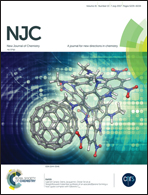Facile synthesis of 3D hierarchical MnO2 microspheres and their ultrahigh removal capacity for organic pollutants†
Abstract
Well-defined 3D hierarchical MnO2 microspheres have been successfully prepared by a simple microwave heating method in just 10 minutes without using any templates, catalysts or organic reagents. The as-synthesized MnO2 microspheres were characterized using XRD, XPS, BET, SEM, TEM and HRTEM methods. The 3D hierarchical MnO2 microspheres have porous structures with high specific surface area (184.32 m2 g−1) and large pore volume (0.416 cm3 g−1). The MnO2 microspheres are composed of ultrathin nanosheets with thicknesses of around 2 nm. The MnO2 microspheres exhibit exceptional catalytic performance for the degradation of methyl blue (MB) in aqueous solution, indicating their strong potential for wastewater treatment. The microspheres degrade 95% of MB (400 mg L−1) within 25 minutes in the presence of H2O2via a Fenton-like reaction. The weight ratio of degraded MB to MnO2 microspheres (40 mg mg−1) is the highest among all reported catalysts for MB. The MnO2 microspheres also demonstrate efficient performance as a reactive sorbent for organophosphate pesticides, with 90% of parathion methyl degraded within 100 minutes in non-polar organic solvent (n-heptane). The ultrahigh removal capacity can be ascribed to the high specific surface area, porous structure and ultrathin nanosheets that are the building blocks of the MnO2 microspheres.



 Please wait while we load your content...
Please wait while we load your content...